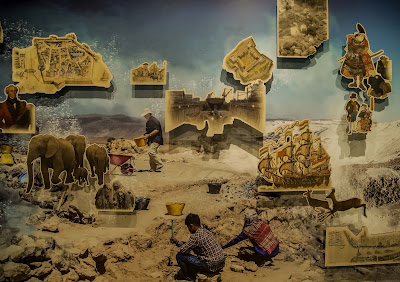截至2019年的工作路徑 Work Paths Until 2019
裝置 Installation,尺寸依場地而定 Dimension Variable,2019Hsu Chia-Wei’s 2008 The Story of Hoping Island centred on the shipyard on Hoping Island, under which lay the 17th-century fortress rebuilt by the Dutch East India Company. Hsu’s creative process has focused on traces leading from this starting point for the past two years. This installation depicts a network of relationships from the initial archaeological site, describing a map of movements as well. The elaborate network extends from Hoping Island across Asia, comprising the Dutch Governor’s House in Malacca built in 1641, the Fort Noord-Holland rebuilt in 1642, and the war between Cambodia and the Dutch in 1644. We also trace relationships between Malacca and William Farquhar of the British East India Company, elephants and Malayan tapirs, the shared Classical Chinese character for both “tapir” and “panda,” and connections between the Dutch East India Company, deerskins, Taiwan and Sengoku-period Japan. These dynamic connections crossing space and time become key images, with three archaeological scenes from the underwater to high mountains as background, featuring in the central map of this exhibition, with connections ever-increasing through the creative process-a use of the modern-day digital internet of Things to peer into the colonial Network of Things.
許家維2008年的作品《和平島故事》曾拍攝和平島上的造船廠,這地點下方埋藏了十七世紀荷蘭東印度公司的北荷蘭城,從此線索出發,成為他近兩年的創作方向。這裝置呈現藝術家從和平島的考古事件所擴展出的關係圖,也是某種行動的路徑。從和平島延伸至亞洲區域,交織出複雜的關係網絡,例如1641年建造的麻六甲荷蘭總督府、1642年改建的北荷蘭城以及1644年發生的柬荷大戰,這三者之間的關聯;麻六甲與英國東印度公司總督威廉・法夸爾(William Farquhar)、大象、馬來貘之間的關係;馬來貘與熊貓在字源學上的同源;荷蘭東印度公司、鹿皮、台灣與日本戰國時代的連結等等。這些跨越時空的元素成為關鍵字影像,以水下到高山的三種考古現場作為背景,在關係圖中呈現出相互的動態連結,並隨著創作行動的過程中不斷增生,試圖以今日數位的物聯網思考方式,觀看殖民時代的物聯網。
 |
| 黃宏錡攝影 北師美術館提供 |
 |
| 黃宏錡攝影 北師美術館提供 |




